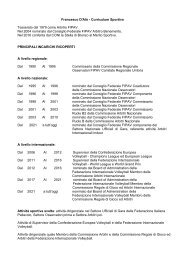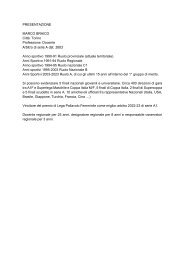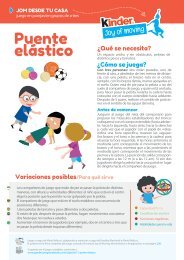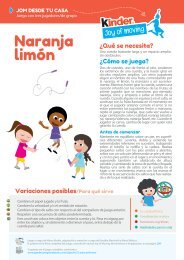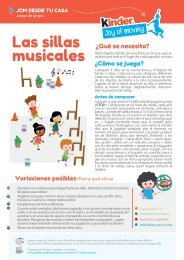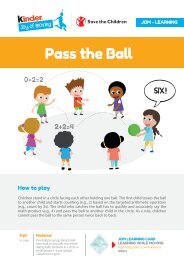Disappearing Act
You also want an ePaper? Increase the reach of your titles
YUMPU automatically turns print PDFs into web optimized ePapers that Google loves.
<strong>Disappearing</strong> <strong>Act</strong><br />
What makes some coordination patterns<br />
more automatic than others?<br />
I<br />
n “Party Tricks,” I asked you to form pistols with your two hands and move<br />
your index fingers rhythmically in either an in-phase or an antiphase<br />
pattern. Both patterns are easy to do and require no practice to perform<br />
effectively and efficiently. Now I want you to try something different. Using<br />
your finger pistols again, start moving in an in-phase pattern at a slow<br />
pace—say, one full cycle per second (1 Hz). Then slowly start to pick up the<br />
pace, gradually going faster and faster. You will find that it is rather easy to<br />
maintain the in-phase pattern. Now try the same thing beginning with the<br />
antiphase pattern at a slow speed, then gradually going faster and faster.<br />
If you perform like the students who do this in my classes, then at some<br />
point you will probably find that the antiphase pattern becomes more<br />
difficult to maintain; the stability of the pattern starts to fall apart. But<br />
something very interesting happens as the fingers are wiggled still faster<br />
and faster. Rather than the antiphase pattern completely disappearing<br />
into two randomly waving pistols, the pattern tends to be replaced by the<br />
in-phase pattern.<br />
As was discussed in “Party Tricks,” we have the capacity to move just these<br />
two simple degrees of freedom in an infinite number of independent ways.<br />
The in-phase and antiphase patterns appear to represent the most natural<br />
of this infinite repertoire of patterns. Moreover, when speed becomes a<br />
factor, we find that the in-phase pattern is the dominant solution, at least for<br />
this finger-wiggling task.<br />
So, what is going on here? Several views have been forwarded, and each<br />
appears to be supported by research. According to one view, the coordination<br />
of multiple degrees of freedom is not directed by conscious intentions, as<br />
might be expected if commanded by the brain, as in a motor programming<br />
point of view. Instead, these patterns emerge, dissolve, and reformulate<br />
spontaneously depending on the self-organizing properties of the central<br />
nervous system and how the limbs interact with the environment and other<br />
conditions. According to this view, the decision about which pattern will<br />
dominate depends largely on how the general intentions of the performer<br />
interact with the self-organizing properties of the central nervous system.<br />
An alternative view of these disappearing patterns is that they represent<br />
varying levels of learning, each associated with different attentional demand<br />
requirements (see “Gumbo” in chapter 6). In-phase and antiphase patterns<br />
can be performed while walking, while talking, and while walking and talking.<br />
From T.D. Lee, 2011, Motor control in everyday actions (Champaign, IL: Human Kinetics).<br />
157
158 Motor Control in Everyday <strong>Act</strong>ions<br />
Researchers sometimes refer to actions of this type as automatic because<br />
they demand little or no attention for successful completion. The in-phase<br />
pattern appears to be consistent with the performance characteristics that we<br />
might expect from an automated pattern. It can be performed at very rapid<br />
speeds or together with other activities with little to no loss in performance<br />
capacity. In comparison, the antiphase pattern is less compatible with this<br />
view of automaticity: the pattern can be maintained only with increased<br />
attention at higher speeds or when combined with other activities, and even<br />
at that, performance will deteriorate. The tendency of the in-phase pattern<br />
to dominate the antiphase pattern is also consistent with the idea that we<br />
“regress” to a more highly learned, more automatic mode of control when<br />
placed in situations that push us to the edge of our performance capabilities.<br />
A strikingly similar finding occurs in the control of gait. The two most<br />
common gaits in humans are walking and running, which propel us at<br />
different speeds. If we start walking at a slow speed and gradually walk<br />
faster and faster, we will want to switch to a running gait at about 4.7 miles<br />
per hour (2.1 m/s). Similarly, if we start running at a rapid pace and then<br />
go slower and slower, there will be a temptation to switch to a walking gait<br />
at roughly the same speed. The point at which this occurs is different for<br />
people of different shapes and sizes, but the transition is a natural response<br />
to increased energy demands because the gait we are using is no longer<br />
optimized for locomotion at that speed. However, if we intentionally continue<br />
to walk faster (or run slower) at speeds beyond the normal transition point,<br />
we will experience an increased variability in stride frequency and length.<br />
The dissolution and reformation of coordination patterns reveals<br />
something quite interesting about the central nervous system. Although<br />
there is a tendency to associate variability with an increased likelihood<br />
of errors or accidents (e.g., see “The Calculator” and “The Gimme Putt” in<br />
chapter 3), this is not always the case. What we have discussed here is that<br />
the variability and error in the performance of certain patterns increase<br />
only when we intentionally try to resist a switch to a pattern that is better<br />
suited for the changed conditions (e.g., resisting the switch from antiphase<br />
to in-phase when moving faster and faster). Instead, when we let patterns<br />
dissolve and reformulate as new patterns, reductions in error are likely to<br />
occur. The conscious decision to resist the pattern dissolution is what results<br />
in the increased error. It seems as though sometimes our bodies are smarter<br />
than we are.<br />
Self-Directed Learning <strong>Act</strong>ivities<br />
1. What does pattern switching refer to in the context of movement<br />
coordination?<br />
2. How does an energy demand view of locomotion coordination differ<br />
from an attention demand view?<br />
From T.D. Lee, 2011, Motor control in everyday actions (Champaign, IL: Human Kinetics).
Motor Control<br />
159<br />
3. In the example, the antiphase coordination pattern disappeared and<br />
was replaced by an in-phase pattern as movement speeds increased.<br />
Why don’t we start hopping when we run faster and faster?<br />
4. Suppose, during the performance of a finger-wiggling task, you<br />
intentionally tried to switch from an in-phase pattern to an antiphase<br />
pattern (and vice versa). Which would be more difficult to do? How<br />
would you conduct such an experiment, and what measure of switching<br />
performance would provide the best indication of the relative difficulty<br />
of these two intentional switches?<br />
Notes<br />
• The switch from an antiphase pattern to an in-phase pattern is not obligatory<br />
at high speeds, but must be counteracted intentionally to fight the<br />
attraction to an in-phase pattern, as discussed in the following studies:<br />
Lee, T.D., Blandin, Y., & Proteau, L. (1996). Effects of task instructions<br />
and oscillation frequency on bimanual coordination. Psychological<br />
Research, 59, 100-106.<br />
Smethurst, C.J., & Carson, R.G. (2003). The effect of volition on the<br />
stability of bimanual coordination. Journal of Motor Behavior, 35,<br />
309-319.<br />
• Changing gait patterns in four-legged animals is another fascinating<br />
area of research and reveals that some animals switch among five or six<br />
gait patterns, and do so for varying reasons. The following references<br />
are essential reading in this area:<br />
Hoyt, D.F., & Taylor, C.R. (1981). Gait and the energetics of locomotion<br />
in horses. Science, 292, 239-240.<br />
Alexander, R.M. (2003). Principles of animal locomotion. Princeton,<br />
NJ: Princeton University Press.<br />
Suggested Readings<br />
Diedrich, F.J., & Warren, W.H. Jr. (1995). Why change gaits? Dynamics<br />
of the walk-run transition. Journal of Experimental Psychology: Human<br />
Perception and Performance, 21, 183-202.<br />
Diedrich, F.J., & Warren, W.H. Jr. (1998). Dynamics of human gait<br />
transitions. In D.A. Rosenbaum & C.E. Collyer (Eds.), Timing of behavior:<br />
Neural, psychological, and computational perspectives (pp. 323-343).<br />
Cambridge, MA: MIT.<br />
Kelso, J.A.S., Scholz, J.P., & Schöner, G. (1986). Nonequilibrium phase<br />
transitions in coordinated biological motion: Critical fluctuations.<br />
Physics Letters A, 118, 279-284.<br />
From T.D. Lee, 2011, Motor control in everyday actions (Champaign, IL: Human Kinetics).
160 Motor Control in Everyday <strong>Act</strong>ions<br />
Schmidt, R.A., & Lee, T.D. (2011). Coordination. In Motor control and<br />
learning: A behavioral emphasis (5th ed., pp. 263-296). Champaign,<br />
IL: Human Kinetics.<br />
From T.D. Lee, 2011, Motor control in everyday actions (Champaign, IL: Human Kinetics).




